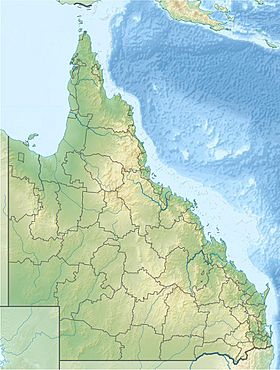Ross River Dam facts for kids
Quick facts for kids Ross River Dam |
|
|---|---|

Ross River Dam at night, with open floodgates, pictured in 2008.
|
|
|
Location of the dam wall in Queensland
|
|
| Country | Australia |
| Location | Between Kelso, Queensland and Mount Stuart, southwest of Townsville, North Queensland |
| Coordinates | 19°24′35″S 146°44′15″E / 19.40972°S 146.73750°E |
| Purpose | Flood control, water supply |
| Status | Operational |
| Opening date | 1971 |
| Dam and spillways | |
| Type of dam | Embankment dam |
| Impounds | Ross River |
| Height | 34.4 metres (113 ft) |
| Length | 8,670 m (28,440 ft) |
| Dam volume | 5,085×103 m3 (179.6×106 cu ft) |
| Spillway type | Controlled |
| Spillway capacity | 674 m3/s (23,800 cu ft/s) |
| Reservoir | |
| Total capacity | 803,565 ML (1.76760×1011 imp gal; 2.12279×1011 US gal) |
| Active capacity | 233,187 ML (5.1294×1010 imp gal; 6.1601×1010 US gal) |
| Catchment area | 750 km2 (290 sq mi) |
| Surface area | 82,000×103 m2 (880×106 sq ft) |
The Ross River Dam is a large dam built across the Ross River in Queensland, Australia. It is located between the towns of Kelso and Mount Stuart, near Townsville. The dam is made of rock and earth.
Its main jobs are to control floods and store water. The lake created by the dam is called Lake Ross. This lake is a very important source of drinking water for the whole region. In February 2019, the dam became very full, reaching 250% of its normal capacity. This happened because of a lot of rain and flooding in the area.
What the Dam Does and Where It Is
The Ross River Dam was built in 1971 by Leighton Contractors. Its main goals were to help stop floods and to store water for people to use. After some big improvements in 2007, the dam can now hold about 250,000 megalitres (ML) of water.
The dam wall is very long, about 8.67 kilometres, and stands 34.4 metres high. The area that collects water for the dam, called the catchment area, covers 750 square kilometres. The dam has special gates that can be controlled to let water out.
The lake can hold 233,187 ML of water for everyday use. During floods, it can hold much more, up to 803,565 ML. When the dam gates open, water flows into the Ross River.
You can visit Ross Park to see the dam from a special viewing platform. The Ross Dam Pump Station sends up to 232 ML of water to the Douglas Water Treatment Plant. Here, the water is cleaned and treated before it goes to Townsville for people to drink.
Ross Park is located at the bottom of the dam, right by the Ross River. It's a great spot for picnics and barbecues, and it has public toilets.
Why the Dam Wall Was Upgraded
Experts looked at the dam's safety and how it was built. They wanted to make sure it met world standards.
- 2001: A group of experts started studying the dam. They checked its construction and safety over two years.
- 2003: Their report showed that the dam needed upgrades. The dam was moving about 10 centimetres each year. If this continued, parts of the dam could have failed within 10 years. This would have caused floods in the suburb of Kelso. The first step was to make the spillway 3.5 metres lower. This was done to prepare for new gates that would control water flow and storage levels.
- 2004: A team from GHD-MWH was chosen to design the rest of the work. They also managed the project.
- 2005: Two companies, John Holland Group and Macmahon, won the contract to build the upgrades.
- 2006: Construction began. Workers built sand filters, added more earth and rock to the dam wall, and started building the new gates.
- 2007: The project was finished by late 2007, earlier than planned.
The new spillway gates have made the dam's storage capacity about nine percent larger. This means it can hold an extra 21,000 ML of water, which is like having four more months of water supply. Three large gates now cover the 40-metre wide spillway. The upgrade cost around AUD$115 million.
The dam's storage was made smaller for a while when the spillway was lowered. This was done to make space for the new floodgates, which are now in place.
Water is also supplied to nearby areas from the Burdekin Dam. Water is released from Burdekin Dam into the Burdekin and Haughton Rivers. Special structures called weirs control how much water goes into each river. The Haughton pumping station then sends water through a pipeline to the Ross River Dam. This pipeline was built in 1988.


